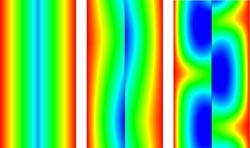Magnetic fields slow down stars

Numerical Simulations show a strong disturbation of the magnetic fields inside a star for higher than critical magnetic field values. Credits: AIP<br>
Researchers from the Leibniz-Institut für Astrophysik Potsdam (AIP) made simulations of the magnetic fields of stars and compared the results with measurements from a laboratory experiment done at the Helmholtz-Zentrum Dresden-Rossendorf (HZDR).
The aim and result of this experiment was to detect, for the first time, a magnetic instability that had been theoretically predicted but never directly observed in a star. This magnetic effect would enhance the viscosity of hot plasma inside a star, leading to a strong deceleration of its core.
“We have known for years that the Tayler instability is an effective mechanism to explain the deceleration of stars, but until now there was no proof of its existence,“ says Günther Rüdiger, the principal investigator at AIP. “This experiment confirms our numerical predictions very well!“ adds Marcus Gellert, who conducted computer simulations to prepare the experiment.
In order to correlate with the low rotation rates observed in white dwarfs, or neutron stars, which are stars at the end of their life cycle, the core rotation rate of a solar-like star would have to drop by ninety percent. A permanently active magnetic instability could decelerate the core of a star very effectively and would explain observations in a simple and elegant way.
The extent to which these laboratory results can be transferred to a real star has to be shown via new simulations and comparisons with observations in the near future. The confirmation of the Tayler instability underlines the importance of magnetic fields in stars and could be an important step towards creating more consistent models of stellar evolution.
The GATE experiment is a successor to the award-winning “PROMISE“ experiment which, in 2010, proved the existence of so-called magnetorotational instability (MRI), demonstrating a second successful partnership between astronomers from AIP and scientists at HZDR in shedding more light on stars in the lab.
The key topics of the Leibniz Institute for Astrophysics are cosmic magnetic fields and extragalactic astrophysics. A considerable part of the institute's efforts aim at the development of research technology in the fields of spectroscopy, robotic telescopes, and e-science. The AIP is the successor of the Berlin Observatory founded in 1700 and of the Astrophysical Observatory of Potsdam founded in 1874.
The latter was the world's first observatory to emphasize explicitly the research area of astrophysics. The AIP is a foundation according to civil law and is a member of the Leibniz Association. The Leibniz Association is a network of 86 independent research institutes and scientific service facilities, which strive for scientific solutions for major social challenges.
Science contact: Prof. Dr. G. Rüdiger, gruediger@aip.de; Dr. M. Gellert, mgellert@aip.de, Tel.: +49 331 7499 530
Press contact:
Dr. Gabriele Schönherr / Kerstin Mork, presse@aip.de Tel.: +49 331 7499 469
Weitere Informationen:
http://arxiv.org/abs/1201.2318
Rüdiger G., Gellert M., Schultz M., Strassmeier K.G., Stefani F., Gundrum Th., Seilmayer M., Gerbeth G.: Critical fields and growth rates of the Tayler instability as probed by a columnar gallium experiment
http://prl.aps.org/abstract/PRL/v108/i24/e244501
Martin Seilmayer, Frank Stefani u.a.: Evidence for transient Tayler instability in a liquid metal experiment, in: Physical Review Letter
Media Contact
More Information:
http://www.aip.deAll latest news from the category: Physics and Astronomy
This area deals with the fundamental laws and building blocks of nature and how they interact, the properties and the behavior of matter, and research into space and time and their structures.
innovations-report provides in-depth reports and articles on subjects such as astrophysics, laser technologies, nuclear, quantum, particle and solid-state physics, nanotechnologies, planetary research and findings (Mars, Venus) and developments related to the Hubble Telescope.
Newest articles

“Nanostitches” enable lighter and tougher composite materials
In research that may lead to next-generation airplanes and spacecraft, MIT engineers used carbon nanotubes to prevent cracking in multilayered composites. To save on fuel and reduce aircraft emissions, engineers…

Trash to treasure
Researchers turn metal waste into catalyst for hydrogen. Scientists have found a way to transform metal waste into a highly efficient catalyst to make hydrogen from water, a discovery that…

Real-time detection of infectious disease viruses
… by searching for molecular fingerprinting. A research team consisting of Professor Kyoung-Duck Park and Taeyoung Moon and Huitae Joo, PhD candidates, from the Department of Physics at Pohang University…





















